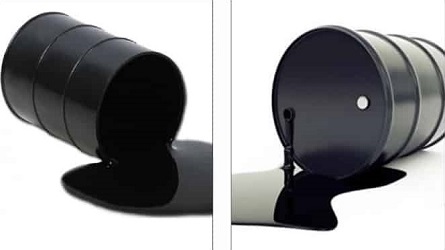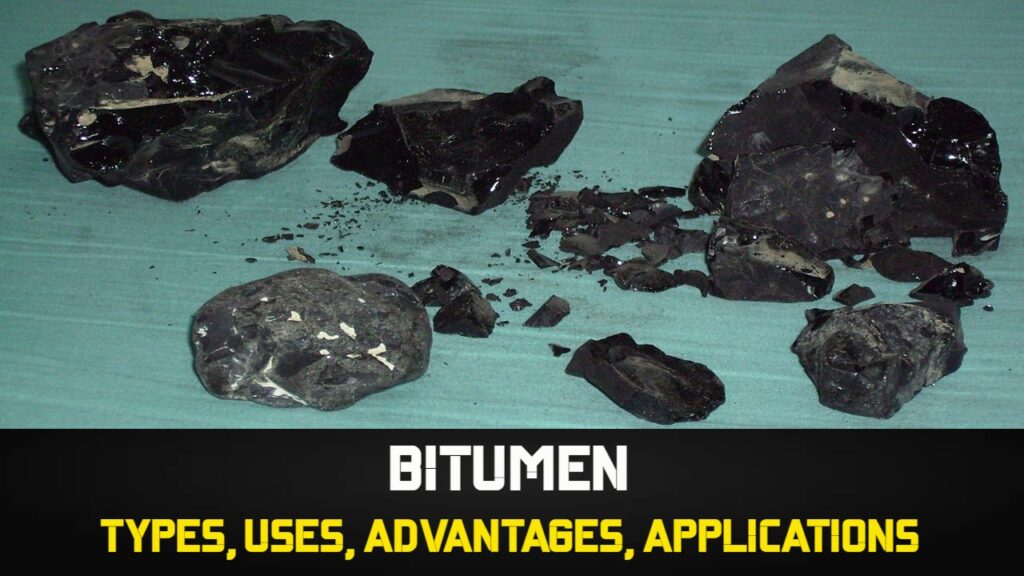In this post, we will learn Glossary Relating To Bitumen And Tar. All these terms are very important for civil engineers.
Glossary Relating To Bitumen And Tar

A
Adhesion — The property by means of which material in a liquid or semi-solid form adheres or sticks to the surface of a solid body. It is achieved by the molecular attraction of molecules of two different bodies.
Adhesion Active — When bitumen in the hot condition is able to coat wet aggregates, it is termed as active adhesion.
Adhesion Agent — A substance used for the purpose of improving the adhesion or bond between the solid body and the binder used to coat it.
Adhesion Passive — When aggregates coated with bitumen are immersed in water and bitumen film is retained, it is called passive adhesion.
Anthracene Oil — The heavy fraction of distillate oil obtained from coal tar (above 300” C) having a specific gravity between 1.05 and 1.1 at 38°C.
Ash — Inorganic residue remaining after ignition of combustible substances.
Asphalt — A natural or artificial mixture in which bitumen is associated with inert mineral matter. The word ’asphalt’ should always be qualified by indication of its origin or nature.
Asphaltic Bitumen — A subdivision of the generic bitumen, which is manufactured by the oil industry from petroleum.
Asphaltenes — The hydrocarbon fraction of bitumen which is soluble in carbon disulphide, but insoluble in n-heptane/n-pentane, etc.
Asphalt, Lake — A solid or semi-solid naturally occurring asphalt existing in well-defined surface deposits.
Asphalt, Mastic — An intimate mixture of mineral fillers, well-graded sand and or stone chippings with a hard grade of bitumen, cooked and laid hot manually or mechanically. The mixture settles to a coherent, void less and impermeable solid or semi-solid mass under normal atmospheric temperature condition.
Asphalt, Natural or Native — A mixture occurring in nature in which bitumen is associated with inert mineral matter.
Asphalt, Rock — A naturally occurring rock formation, usually calcareous, sandstone in the pores and veins, of which is found impregnated.
B
Bitumen — A black or dark brown non-crystalline solid or viscous material having adhesive properties, derived from petroleum either by natural or refinery processes and substantially soluble in carbon disulphide.
Bitumen, Blown — Bitumen, the properties of which are modified by blowing air through it at a comparatively high temperature and pressure.
Bitumen, Concrete (Asphaltic Concrete) — A well-graded mixture of high-quality aggregates with a designed proportion of bitumen, hot mixed hot laid and rolled into a uniform dense mass with specified design criteria.
Bitumen Cutback — Bitumen, the viscosity of which is reduced with suitable violative diluent usually a petroleum distillate.
Bitumen Cutback Rapid Curing — Bitumen, which is blended with a naphtha type distillate.
Bitumen Cutback, Medium Curing — Bitumen, which is blended with a kerosene-type distillate.
Bitumen Cutback Slow Curing — Bitumen, which is blended with high boiling oils or containing a higher viscous oil than in medium or rapid curing cutback.
Bitumen Cutback, Digboi Type — A cutback bitumen made out of bitumen from paraffinic crude of Assam.
Bitumen, Digboi Type — Bitumen obtained from the processing of paraffinic crude of Assam.
Bitumen Emulsion — A liquid product in which a substantial amount of bitumen is dispersed in a finely divided droplet in an aqueous medium containing an emulsifier and a stabilizer.
Bitumen Emulsion, Anionic — An emulsion in which the anion of the emulsifier is at the interface with the bitumen particles, which are negatively charged and the aqueous phase is alkaline.
Bitumen Emulsion, Cationic — An emulsion in which the cation of the emulsifier is at the interface with the bitumen particles, which are positively charged and the aqueous phase is acidic.
Bitumen Emulsion, Rapid Setting — A quick setting emulsion used for surface treatment, penetration macadam and tack coat.
Bitumen Emulsion, Medium Setting — A medium breaking emulsion used for plant or road mixes with tine aggregates between 5 per cent and 20 per cent retained on 2.36 mm sieve. Used for open-graded premix work and bituminous macadam.
Bitumen Emulsion, Slow Setting — A slow breaking emulsion used for plant or road mixes with graded tine aggregates greater than 20 per cent, passes a 2.36 mm sieve and a portion of which may pass a 75 μm sieve. Used in slurry seal, seal coat, soil/sand stabilization, etc.
Bitumen, Fluxed — Paving bitumen, a viscosity of which is reduced by adding a substantially non-volatile diluent.
Bitumen, Industrial — Also known as blown or oxidized bitumen used in a variety of industrial applications.
Bitumen, Liquid — Bitumen having a penetration of more than 350 at 25°C under a load of 50 g applied for one second.
Bitumen, Macadam — An open-graded mixture of high-quality aggregate with the designed proportion of bitumen hot-mixed and hot-laid and rolled into ‘c’ most.
Bitumen, Paving — Solid or semi-solid bitumens of specified penetration used for paving roads, airfields, etc.
Bitumen Rubberized — A straight run bitumen whose characteristics have been modified by the addition of crumb or natural rubber.
Bitumen Polymer Modified — A straight run bitumen, the characteristics of which have been improved by the addition of polymers, namely, styrene-butadiene-styrene (SBS), ethyl vinyl acetate (EVA) or polyethene (PE).
Bitumen, Semi-Solid — Bitumen having a penetration of more than 10 at 25°C under a load of 100 g applied for 5s and penetration of not more than 350 at 25°C under a load of 50 g applied for one second.
Bitumen, Solid — Bitumen having a penetration of not more than 10 at 25°C, under a load of 100 g applied for 5 s.
Bitumen, Steam Refined — Residue from the distillation of crude petroleum processed further with the injection of steam to a specified viscosity or penetration.
Bitumen, Straight Run — Bitumen obtained as the end product or residue from the refining of crude petroleum under direct distillation.
Bitumen Primer — A cut-back bitumen product of low viscosity that penetrates into a base/sub-base and stabilizes loose particles upon application.
Bituminous — Containing or treated with, bitumen, tar or other similar materials.
C
Carbenes — The organic components of bitumen which are soluble in carbon disulphide but insoluble in carbon tetrachloride.
Carboys — The inorganic matter present in bitumen which is insoluble in carbon disulphide.
Carbon, Fixed — The organic matter of residual coke obtained from heating hydrocarbon products in a covered vessel in the absence of oxygen.
Cohesion — It is the molecular attraction of the molecules of the same product. In bitumen molecular attraction is revealed by ductility test.
Creosote Oil — The oils or a blend of oil fractions obtained from coal tar, when distilled between 200°C and 300°C.
Curing — The process of evaporation of the volatile petroleum oils from bitumen in cut-back bitumen.
D
Dielectric Strength (Electric Strength) — A measure of the electrical insulating properties of bitumen, as the breakdown occurs when a specified voltage is reached when an increasing alternating voltage is applied to a sample under specified conditions. The dielectric strength is measured in kV/mm and depends upon the conditions of testing.
Ductility — The property by which a material can be drawn in a fine thread without breaking. For bitumen, it is measured by the distance in centimetres to which it will elongate before breaking when two ends of a briquette specimen of the material of the specified form and cross-section are pulled apart under a specified speed and temperature.
Dynamic Shear Rheometer — An equipment used to measure the dynamic properties of bitumen under cyclic loading.
E
Emulsifier/Emulsifying Agent — An additive of the anionic or cationic type to facilitate dispersion of two immiscible phases in fine droplets of 5 pm to 20 pm diameter.
Emulsion Breaking — The coagulation of the dispersed material in an emulsion whereby it separates from the aqueous part of the emulsion.
Emulsion, Stability — The property of an emulsion whereby it resists coagulation to cause breaking.
Equiviscous Temperature (EVT) — The temperature in degrees centigrade at which time for the outflow of 50 ml material is 50 s as measured by the standard tar viscometer (STV) using 10 mm cup.
F
Fire Point — The lowest temperature at which the material gets ignited and burns continuously under specified conditions of the test.
Flash Point — The lowest temperature at which the vapour of the material can be ignited momentarily by a flame under specified conditions of the test.
Float Value — A measure of the consistency of cut-back bitumens and is the time in s elapsed between placing a briquette bitumen in water and the water breaking through it under specified conditions of test and temperature. The normal testing temperature is 50°C.
Flux Oil — A substantially volatile/non-volatile diluent used for reducing the viscosity of bituminous materials.
FRASS Breaking Point — The temperature at which bitumen first becomes brittle as indicated by the appearance of cracks, when a thin film of bitumen on a metal plate is cooled and flexed in accordance with specified conditions of the test.
L
Loss on Heating — The loss in mass of water, oil and other constituents of bitumen when heated at a standard temperature of 163°C for 5 h under specified conditions of the test.
N
Natural Bitumen: Natural bitumen or Gilsonite can be extracted from the mines in the lump form with different ash content. These lumps can be used in the same form in industry. But, for easier and faster progress in work, it can also be used as a micronized powder. Natural bitumen can be used in different cases including drilling mud, as an additive in road and construction, Isolation, Foundry and printing industry.
Infinity Galaxy explains: What is Natural Bitumen or Gilsonite?
Newtonian Liquid — It is a liquid in which the rate of shear is proportional to the shearing stress. The ratio of the shearing stress to the rate of shear is termed as the viscosity of the liquid. If this ratio is not constant, the liquid is termed as non-Newtonian.
O
Oils — The constituent of bitumen obtained after separation of resins from maltenes.
P
Penetration — A measure of hardness or consistency of the bitumen. It is the vertical distance traversed by a standard needle entering the material under specified conditions of load, time and temperature; and is expressed in one-tenth of a millimetre.
Penetration Ratio — It is the ratio of penetration at 4°C, 200 g, the 60s to penetration at 25°C, 100 g, 5 s. It is a measure of temperature susceptibility of the material.
Phenols — An oily constituent of coal tar, coal tar fractions or hydrogenated coal products, soluble in an aqueous caustic soda solution.
Pitch, Coal Tar — The black or dark brown, solid or semi-solid, fusible and agglomerative residue remaining after partial evaporation or fractional distillation of coal tar.
Pitch, Mastic — A well-graded mixture of mineral matter and coal tar pitch suitably blended, cooked and laid hot manually or mechanically by a suitable float.
R
Resins — The dark brown sticky constituent of bitumen separated by absorption on Fuller’s earth, silica gel, etc, from the maltenes.
The residue of Specified Penetration — It is the percentage by mass of a residue obtained by heating a bituminous material to the required temperature and having a specified penetration value,
Road Oil — A heavy petroleum distillate usually employed for the preparation of slow curing cutbacks.
Road Tar — A product obtained by blending pitch, anthracene oil and creosote oil in such a manner that it conforms to a specification which defines its suitability for road use.
S
Setting — A process by which a bitumen emulsion breaks-by neutralization of charge or evaporation water and thereby reverting to original bitumen.
Softening Point — The temperature (in °C) at which a standard ball passes through a sample of bitumen in a mould and falls through a distance of 2.5 cm when heated underwater or glycerin at specified conditions of the test.
Specific Gravity — The ratio of the mass of a given volume of a material to the mass of an equal volume of water, the temperature of both being specified.
Stripping — The displacement of coated bituminous film from the surface of a road stone in the presence of water.
T
Tack Coat — Bitumen, road tar or an emulsion sprayed as a thin film on a surface to achieve the adhesion with a superimposed course,
Tar — A viscous material having adhesive properties, obtained from the destructive distillation of certain types of organic materials. The word ‘tar’ shall be preceded by the name of the material from which it is obtained, that is, coal, shale, peat, etc. Its mode of production shall also be indicated.
Tar, Coal (Crude Coal Tar) — Tar produced by the destructive distillation of bituminous coal.
Tar, Coke Oven — Tar produced as a by-product in a coke oven plant where coal is heated in a coke oven above 1000°C.
Tar, Emulsion — An emulsion in which fine droplets of tar are suspended in water with a suitable emulsifier.
Tar, Gas House — Tar produced in retorts during the production of illuminating gas from coal.
Tar, High Temperature — The tar obtained as a by-product in high-temperature carbonization of coal. In high-temperature carbonization, coal is heated above 1000°C.
Tar, Horizontal Retort — Tar obtained as a by-product in the carbonization of coal in a horizontal retort.
Tar, Low Temperature — It is obtained by low-temperature carbonization of inferior quality coal. Such tars are generally rich in phenolic components. In low temperature, inferior quality coal is heated to 750°C to 1000°C.
Tar, Refined — Tar obtained by direct distillation of coal tar or by fluxing tar pitch with anthracene oil and creosote oil to the required consistency.
Tar, Vertical Retort — Tar obtained as a by-product in carbonization of coal in vertical retorts.
Tar, Wood — Tar obtained from the destructive distillation of wood.
V
Viscosity— The property of a liquid by which it resists flow due to internal friction and is measured by the ratio of the shearing stress to the rate of shear and is called the coefficient of viscosity.
Viscosity, Absolute or Dynamic of a Newtonian Liquid — It is the tangential force required to maintain a velocity between the two layers unit distance apart. The CGS unit for viscosity is poise.
Viscosity, Kinematic — The ratio of the absolute viscosity to the density of the liquid. It is a measure of the resistance to flow of a liquid under gravity. The S1unit of kinematic viscosity is m2/s for practical use a submultiple of (mm2/s) is more convenient. The unit cent stroke is 1 mm2/s and is used customarily.
W
Water Content — The quantity of water present in a material and expressed as a per cent by weight of the material.
I hope you find this information useful. If there is something that I have missed or I do not know, you can comment and tell me which I will try to rectify as soon as possible.
If you have liked this post of mine, then use the social link given below and share it among your friends on social media. Thanks
Source – IS 334: 2002
SHARE THIS POST, IF YOU LIKE IT !!
Padhega India Tab Hi Badhega India | पढ़ेगाइंडियातबहीबढ़ेगाइंडिया








Thaks sir for your efforts